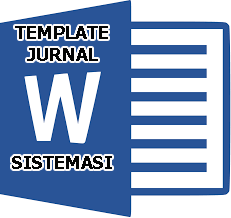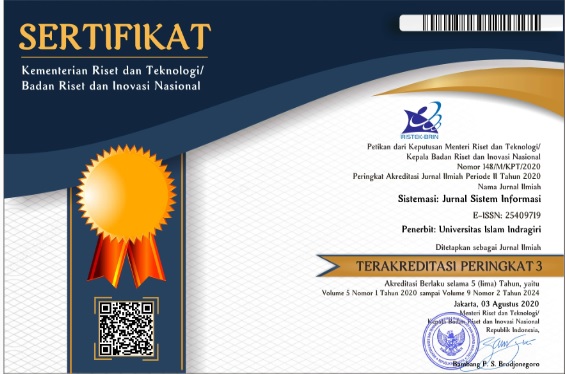Design of an IoT-Based 4-Channel 5V Relay Controller Using WiFi and Smartphone Integration
Abstract
The primary advantages of the system include its universal chat-based interface, low cost, and simple design, accessible from any geographical location with a stable internet connection. However, the system is limited by its dependence on electricity supply and WiFi stability. Therefore, the implementation of this system in smart homes is recommended with the support of a backup power source to improve reliability. In conclusion, the system not only fulfills technical performance requirements but also contributes to energy efficiency in alignment with green economy principles.
Keywords
Full Text:
PDFReferences
H. Sujadi and T. Wahyuni, “Implementasi Stop Kontak Pintar pada Lampu Taman dengan menggunakan Mikrokontroller Wemos D1 R1 Berbasis Iot,” J-Ensitec, vol. 8, no. 01, pp. 574–581, 2022, doi: 10.31949/jensitec.v8i01.1908.
A. H. M. Nasution, S. Indriani, N. Fadhilah, C. Arifin, and S. P. Tamba, “Pengontrolan Lampu Jarak Jauh dengan Nodemcu menggunakan Blynk,” J. TEKINKOM, vol. 2, pp. 93–98, 2019.
A. Rusdi, S. Yanti, M. D. Yulianto, and Djamaludin, “Aplikasi Sistem Alat On/Off Pada Kipas Angin Dengan Arduino Uno dan GSM Modul/SIM900A dengan Metode Rapid Aplication Development,” JIMTEK J. Ilm. Fak. Tek., vol. 1, no. 1, pp. 20–23, 2020.
I. Fitriyanto and F. Amri, “Rancang Bangun Alat Kontrol Saklar Listrik Jarak Jauh berbasis Node-Mcu dan Telegram,” J. Rekayasa Energi, vol. 1, no. 1, pp. 36–42, 2022, doi: 10.31884/jre.v1i1.8.
A. K. Lubis and D. Sawitri, “Desain dan Perancangan Alat Pantau Energi Listrik di Rumah Jarak Jauh berbasis IoT,” MeSTErI J., vol. 1, no. 1, pp. 46–53, 2022.
Fatimah and Samsudin, “Perancangan Sistem Informasi E-Jurnal pada Prodi Sistem Informasi di Universitas Islam Indragiri,” J. Perangkat Lunak, vol. 1, no. 1, pp. 33–49, 2019, doi: 10.32520/jupel.v1i1.782.
A. Muni, “Perancangan Aplikasi Remote Desktop berbasis Client-Server,” J. Perangkat Lunak, vol. 5, no. 1, pp. 23–31, 2023, doi: 10.32520/jupel.v5i1.2484.
S. Bahri and Y. Haryono, “Pengendali Jarak Jauh Peralatan Listrik menggunakan Pengenal Suara dan,” Umj.Ac.Id, pp. 1–7, 2019, [Online]. Available: https://jurnal.umj.ac.id/index.php/semnastek/article/view/5171
R. Berlianti and Fibriyanti, “Perancangan Alat Pengontrolan Beban Listrik Satu Phasa Jarak Jauh menggunakan Aplikasi Blynk berbasis Arduino Mega,” Sain, Energi Teknol. Ind., vol. 5, no. 1, pp. 17–26, 2020.
D. Winarti, E. Hutabri, and K. Handoko, “Pengontrolan Lampu dengan Android berbasis Mikrokontroler Via Hotspot menggunakan Voice Recognition,” J. TEKINKOM, vol. 6, no. 1, pp. 204–212, 2023, doi: 10.37600/tekinkom.v6i1.827.
M. T. Nurhadiyan and A. E. Saputro, “Sistem Kendali Saklar Lampu Jarak Jauh menggunakan SMS berbasis Mikrokontroleratmega328/Arduino Uno,” Prosisko, vol. 6, no. 2, pp. 144–152, 2019,[Online].Available:http://e-jurnal.lppmunsera.org/index.php/PROSISKO/article/view/ 1635
D. M. Wonohadidjojo and J. A. Wibawa, “Sistem Pemantauan dan Pengendalian Alat Elektronik dengan Stop Kontak Pintar menggunakan Aplikasi Smartphone,” J. Sist. dan Teknol. Inf., vol. 11, no. 2, p. 330, 2023, doi: 10.26418/justin.v11i2.56366.
M. Ryan Dwiandra et al., “Rancang Bangun Sistem Kontrol Lampu Penerangan menggunakan Aplikasi Android berbasis Mikrokontroller,” vol. 3, no. 1, pp. 10–13, 2020.
Yunus Tjandi, “Prototype Alat Kendali Listrik berbasis Relay Arduino,” Inf. Technol. Educ. J., vol. 1, no. 2, pp. 37–41, 2022, doi: 10.59562/intec.v1i2.232.
K. M. Elistiana and W. M. Baihaqi, “Perancangan Aplikasi Tebak Gambar untuk Anak Tunarungu,” BIOS J. Teknol. Inf. dan Rekayasa Komput., vol. 4, no. 1, pp. 11–17, 2023, doi: 10.37148/bios.v4i1.56.
S.Maisarah, Samsudin, M. Jibril, D. Y. Prasetyo, Zulrahmadi," Design of Liquefied Petroleum Gas (LPG) Leak Detection Tool with Buzzer and Telegram Based on IoT," Sistemasi: Jurnal Sistemasi, Vol.13, No.6, pp.2756-2766, 2024, doi: https://doi.org/10.32520/stmsi.v13i6.4806
DOI: https://doi.org/10.32520/stmsi.v14i3.5111
Article Metrics
Abstract view : 780 timesPDF - 203 times
Refbacks
- There are currently no refbacks.

This work is licensed under a Creative Commons Attribution-ShareAlike 4.0 International License.









